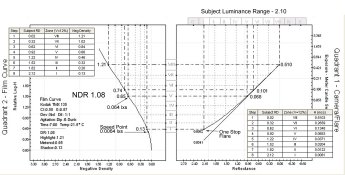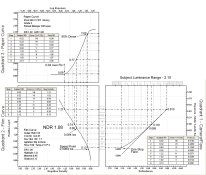So you've put a little flare into the paper curve by enlarging? That's going to help, so you don't have to make a stepping stone diagram that goes up over and down to accommodate more transfers - your fourth quadrant should arrive at the preferred tone reproduction curve.
Bill, interpreting the reproduction curve has to do with subjective tone reproduction , and those types of discussions don't go well, but to briefly sum up some of the factors involved in calculating exposure.
The image illuminance comes from the incident exposure meter calibration equation.
A^2 / T = E*S / C
Where
E = incident light, in footcandles
S = film speed
C = Exposure constant
A = f/number
A^2 / (A*S) * C = E -------- (16^2 / (1/125) * 125) * 30 = 7680 footcandles
Average reflectance in the reflection exposure meter.
R = L / I
Where
R = Reflectance
L = Luminance
I = Illuminance
The exposure constants for reflected and incident exposure meters can be substituted for the actual L and I values.
R = K * pi/ C ------- 1.16 * pi / 30 = 0.121 12%
Exposure for Lg (average luminance).
q * L / A^2 = E ---------- 0.65 * 297*10.76 / A^2 = 8.11 ---------- 8*1/125 = 0.064 lxs




